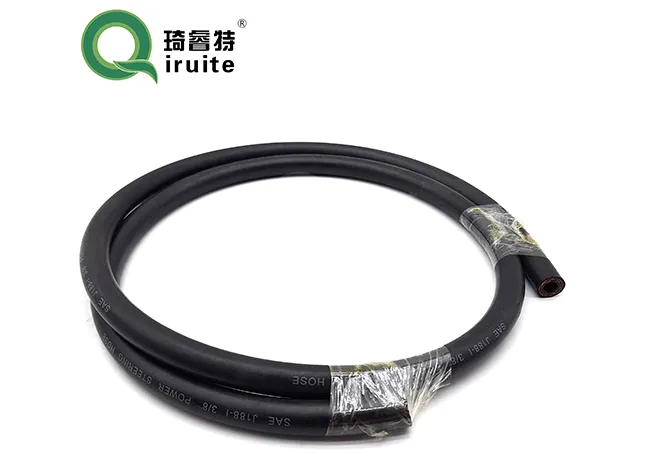brake booster vacuum hose replacement
Brake Booster Vacuum Hose Replacement A Comprehensive Guide
The brake booster is an integral component of a vehicle's braking system, enhancing the driver's effort to slow down or stop the car. This crucial device relies on vacuum pressure to function effectively. Over time, the vacuum hose that connects the brake booster to the engine can wear out, crack, or become loose, leading to reduced braking efficiency and potential safety hazards. In this article, we will discuss the importance of the brake booster vacuum hose, signs of wear, and provide a step-by-step guide on how to replace it.
Understanding the Brake Booster and Vacuum Hose
The brake booster uses vacuum pressure generated by the engine to assist in applying the brakes. It amplifies the force from the brake pedal, allowing for smoother and more effective braking. The vacuum hose is the conduit through which this vacuum pressure is transferred from the engine's intake manifold to the brake booster. A functional vacuum hose is essential for the proper operation of the brake booster.
Signs of a Failing Vacuum Hose
Recognizing the signs of a failing brake booster vacuum hose is critical for maintaining your vehicle's safety. Common symptoms of a damaged or worn vacuum hose include
1. Hard Brake Pedal If the brake pedal feels excessively hard or requires more effort to press down, the brake booster may not be receiving enough vacuum pressure. 2. Hissing Sound A noticeable hissing noise when applying the brakes may indicate that air is leaking through a crack in the vacuum hose.
3. Accurate RPM Fluctuation Irregular engine RPMs can occur if there's a leak in the vacuum system, which may lead to engine performance issues.
4. Brake Warning Light In some vehicles, a malfunctioning brake booster could trigger the brake warning light on the dashboard.
If you notice any of these symptoms, it is imperative to inspect and potentially replace the vacuum hose to ensure your vehicle's braking system functions safely.
Tools and Materials Needed
Before starting the replacement process, gather the necessary tools and materials
brake booster vacuum hose replacement

- New vacuum hose (specific to your vehicle model) - Hose clamps (if needed) - Vacuum pump (optional, for testing) - Basic hand tools (screwdrivers, pliers, wrenches) - Safety goggles and gloves
Step-by-Step Replacement Guide
1. Preparation Park your vehicle on a flat surface and turn off the engine. Engage the parking brake for safety.
2. Locate the Vacuum Hose Open the hood and locate the brake booster, usually found on the driver's side near the master cylinder. Trace the vacuum hose from the booster to the engine intake manifold.
3. Disconnect the Hose Using pliers or a screwdriver, loosen any hose clamps securing the vacuum hose. Carefully pull the hose off the connections at both the brake booster and the intake manifold.
4. Inspect the Old Hose Before discarding the old hose, inspect it for signs of damage, such as cracks, wear, or signs of degradation. This will help determine if the entire assembly was compromised.
5. Install the New Hose Take the new vacuum hose and ensure it matches the length and diameter of the old hose. Connect one end to the brake booster and secure it with a hose clamp. Repeat for the connection to the intake manifold.
6. Check for Leaks If you have a vacuum pump, use it to test the vacuum system for leaks. If not, start the engine and listen for any hissing sounds that may indicate a leak.
7. Final Check Press the brake pedal several times to ensure it feels firm. Make sure there’s no movement or looseness in the connections.
8. Reassemble and Test Drive Reattach any components you removed to access the vacuum hose. Close the hood, start the vehicle, and take it for a test drive to ensure that the brakes are functioning properly.
Conclusion
Replacing a brake booster vacuum hose is a vital maintenance task that can significantly impact your vehicle's braking performance and safety. By being aware of the signs of a failing vacuum hose and following the steps outlined in this guide, you can ensure a safer driving experience. Regular inspections and timely replacements of wear items like the vacuum hose will help keep your braking system in optimal condition and contribute to the overall safety of your vehicle. Always consult your vehicle’s manual or a professional mechanic if you're unsure about any part of the process.
-
Ultimate Spiral Protection for Hoses & CablesNewsJun.26,2025
-
The Ultimate Quick-Connect Solutions for Every NeedNewsJun.26,2025
-
SAE J1401 Brake Hose: Reliable Choice for Safe BrakingNewsJun.26,2025
-
Reliable J2064 A/C Hoses for Real-World Cooling NeedsNewsJun.26,2025
-
Heavy-Duty Sewer Jetting Hoses Built to LastNewsJun.26,2025
-
Fix Power Steering Tube Leaks Fast – Durable & Affordable SolutionNewsJun.26,2025

